An Introduction to Tasmanian Postal Stationery
Allen Shatten
Visit the Postal Stationery forum in our on-line discussion board
Download article as a PDF
In the 1870s, postal administrations of the Australian Colonies began to produce official postal stationery, for sale to and use by the public. This development was not confined to Australia; it occurred throughout the world, coinciding with the establishment of the Universal Postal Union (UPU). Many British Colonies issued postcards and envelopes with similar designs.
Tasmania produced a rich and, sometimes, unique range of postal stationery, beginning with 1d postcards in 1882 and continuing up to the introduction of Commonwealth stationery in 1911. Examples range from common and easily obtained to extremely rare. Some of the envelopes and letter cards are striking little works of art. The local printings of Queen Victoria one penny postcards range from acceptable to almost illegible.
Until recently, Tasmania’s postal stationery was not well-catalogued. The most common reference is Higgins and Gage (H&G), which was not published after 1986 and is quite difficult to use. Many eBay and auction sales refer to H&G numbers. “The Stamps and Postal History of Tasmania”, compiled by W. E. Tinsley and published in 1986, includes an excellent chapter on Tasmanian Postal Stationery, written by O. G. Ingles (FRPSL). However, this book is not readily available and is in narrative rather than catalogue form.
In 2021 the Tasmanian Philatelic Society published “Tasmanian Postal Stationery”, by Malcolm Groom (FRPSL) and Allen Shatten. This book aims to cover all aspects of Tasmanian stationery printed or stamped by the Post Office. “The Courier”, the magazine of the Tasmanian Philatelic Society, is another good source of information.
Broadly, Tasmanian postal stationery can be divided into general issues prepared under the auspices of the Postal Service; “stamped to order” (STO) issues; and stationery for use by government departments. Newspaper wrappers cross the borders of the other categories. All issues can be collected unused or used. The author of this introduction is trying to combine a collection of postal stationery with a collection of pre-1913 Tasmanian postmarks – a pursuit which presents ongoing challenges in display and cross-referencing.
The general issues can be further divided into postcards and reply cards, envelopes, lettercards and registered envelopes. As well as unused and used, many official issues exist with Specimen overprints.
Postcards and Reply Cards
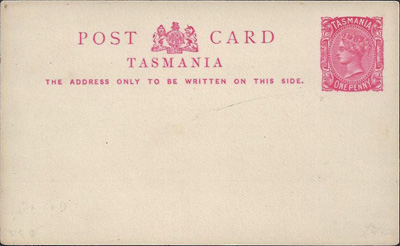
Fig 1
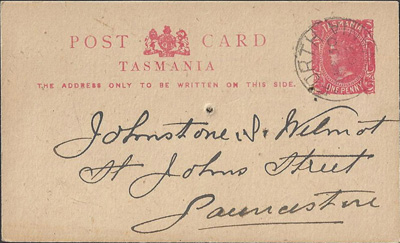
Fig 2
On a simplified basis, a complete collection of postcards and reply cards consists of 9 items. Cards featured the head of Queen Victoria, and the head of King Edward VII.
One of these – the 1½d + 1½d brown reply card, bearing a 1d overprint – is scarce. Another, the 1908 card commemorating the visit of the U.S. fleet in 1908, is rare. The others are readily obtainable.
The 1d unframed Queen Victoria postcard presents a challenge to collectors at any level of specialisation. Nearly 1.4 million of the original cards were printed by De La Rue and Co. The quality is excellent and there are two variations, distinguished by the distance between the full-stop (after the address line instruction) and the edge of the stamp imprint. Subsequent printings (around 2.5 million) were made in Hobart and the quality varies from good to appalling. Amongst these printings there are obvious variations in colour, in the shape of the letters of “POST CARD” and in the paper on which the cards were printed.
It’s relatively easy to distinguish between De La Rue printings and local printings. If you can see the hairs on the horse’s head in the coat of arms, it’s a De La Rue. If you can’t, it’s not.
Some of the printings are rare, but many of the variations are readily available. An emergency lithographed printing is very rare. Figure 1 shows a De La Rue card; figure 2 shows one of the poorer local printings for comparison.
Envelopes
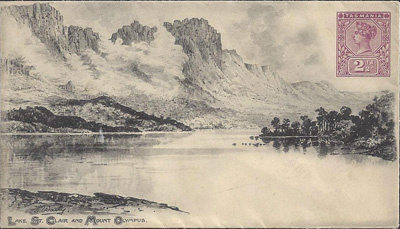
Fig 3
A great many envelopes exist with embossed images (“indicium”, plural “indica”). Most of these are “stamped to order” (STO) envelopes, discussed below.
The Tasmanian Postal Service issued one official envelope for general use, with a 2d green indicum. Envelopes featuring ½d yellow-orange, 1d rose and 2d bluish-green indica were formerly thought to have been issued by the Post Office but are now believed to be STO envelopes. The 2d issue has a sharply pointed flap and is 140 x 78 mm in size. It is readily available and used examples can enhance a postmark collection at modest cost.
The Postal Service also commissioned two sets of “pictorial envelopes”, printed by Waterlow and Sons in London. Each set comprised six Tasmanian views and are jewels of late nineteenth-century engraving. Mr Ingles described them as “singularly attractive …..[perhaps] the most beautiful of all postal envelopes ever issued officially…”
The sets were printed in values of 2d green and 2½d red-purple respectively. The 2d is illustrated on the home page of the TPS website and the 2½d is illustrated here in figure 3. Only around 300 copies of each item were printed. Complete sets are very rare indeed. Individual examples are expensive but come up for sale with surprising frequency. Many of the originals must have been retained for collections or souvenirs.
Lettercards
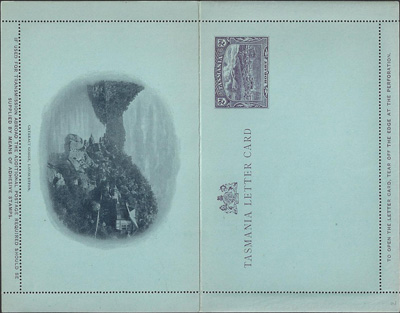
Fig 4
Between 1898 and 1911, the Tasmanian Postal Service issued several series of lettercards. Each card consisted of two joined halves. The upper front half was pre-stamped, with a blank area for details of the addressee, and a Tasmanian view was printed on the lower section. The reverse side was left blank for correspondence. The entire card was surrounded by a perforated outer margin, and the cards could be closed and sealed. By tearing off the outer margin around its perforations, the lettercard could be opened with no interference to the contents.
A complete collection of standard issues would consist of fifty face-different lettercards: two pre-stamped cards with a 2d Queen Victoria sideface image, and 8 different sets of six cards showing the 2d pictorial stamp image. One of the sets of six appears with the 2d stamp impression in two similar shades of violet. The fourth set was printed in multiple colours. The two final sets were emergency printings, for which the 2d stamp image was overprinted “ONE PENNY” at two different angles, following the incorporation of Tasmania into the Australian Commonwealth postal service.
Most of the cards were printed in quantities of 30,000 to 60,000. There is no apparent correlation between quantities printed and scarcity (which has always puzzled the author). Early issues seem to be relatively common and later issues are rarely seen. The emergency surcharges are quite rare; used examples are very rare.
Issue No 57 of “The Courier” includes a catalogue-style listing of Tasmanian Lettercards. One of the first series is illustrated in figure 4.
Registered Envelopes
All of Tasmania’s registered envelopes are in the style of figure 5. This design was widely used in other British Colonies. There are twelve different envelopes (ignoring minor variations); frustratingly, they all look quite similar.
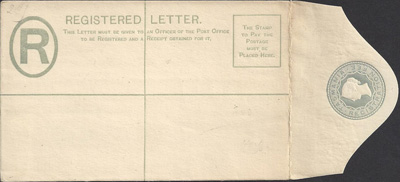
Fig 5
Three different designs, each found in two different sizes, were issued during the period 1883 to 1892. The later of these envelopes was printed in several distinct shades of blue or grey. It is perhaps best to refer to a “configuration” rather than a “design”. The first issue has the flap on the left and the second has the flap on the right. The third issue has no value in the embossed stamp whereas the first two show a value of FOUR PENCE. The first two issues were printed by McCorquodale and the third by De La Rue and the printer’s name appears on the reverse of the envelope.
It is quite difficult to collect all six of these envelopes, let alone the variations in colour. Examples of the McCorquodale envelopes are quite wrinkled, probably due to the effects of air on the thick linen-backed paper over time, but one occasionally finds examples in excellent unwrinkled condition.
A further group was issued from a new set of plates in 1903; this group has straight or V-necked flaps rather than a rounded flap, and no printer’s inscription. A final and slightly different envelope was issued in 1912. This envelope displays the word “REGISTERED” in a frame replacing “REGISTERED LETTER” which appears on all the other issues. These later envelopes are scarce and are rarely available. Used examples of all registered envelopes are hard to find. One member of the final issue is the smallest registered envelope printed in the British Commonwealth.
Wrappers
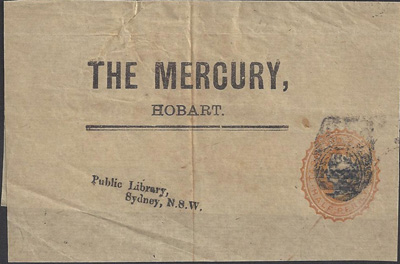
Fig 6
Wrappers were issued for the purpose of enclosing newspapers, and sometimes other papers, transmitted through the mails. Mr Ingles remarked that “… these issues…. are veiled in mystery.” There are no official printing records, or any other records for that matter, for plain wrappers issued prior to 1906. Mr Ingles records seven types and their status may have been official or unofficial – they cross the boundary between official issues and issues printed to private order. Two types of wrapper issued in 1906, bearing the head of King Edward VII, were referred to in postal records and are undoubtedly official.
A subset of wrappers bear the imprints of newspapers or stationers, and these are clearly printed to private order. Those of “The Mercury”, “The Tasmanian Mail” and “The Examiner” are not uncommon – they must have been printed in large quantities. An example is shown in figure 6.
Other wrappers can be found with multiple stamp impressions in a variety of combinations, for sending the contents overseas. The record is six impressions of the ½d yellow-orange indicium, undoubtedly Stamped to Order.
Unused wrappers are not difficult to collect, although their condition varies from fine to tattered. Used wrappers are less common and are of interest because they can help to establish the period of use.
Stamped to Order (STO) Stationery
Stamped to Order envelopes were formerly known as “Printed to Private Order”.
The Tasmanian Postal Guide, No. 1, 1891, provided for the impression of stamps on envelopes and newspaper wrappers “supplied by the public”.
No fewer than 480 envelopes of the same size could be stamped at any one time. There was no fee for the stamping process itself. A commission of 4% was allowed to “licensed vendors and postmasters”. It is probable that some of these envelopes were impressed in considerable quantities.
The philatelic merit of these envelopes is debatable. They have been much maligned by eminent philatelic bodies. However, once impressed, each envelope was pre-stamped and could be used by anyone for the carriage of correspondence. It is reasonable to define their status as an early form of pre-stamped envelope.
The most common approach to collecting STOs is to obtain different combinations of stamp impressions – indica – of which there are many. There are at least 80 different known combinations, allowing for major colour variations, of ½d, 1d and 2d impressions. Variations include positions of indica on the envelope, as shown in figure 7, as well as the combinations of indica themselves.
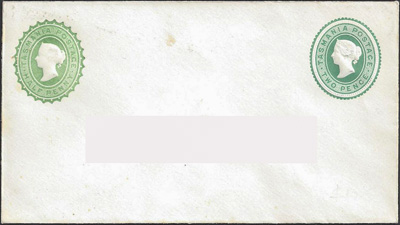
Fig 7
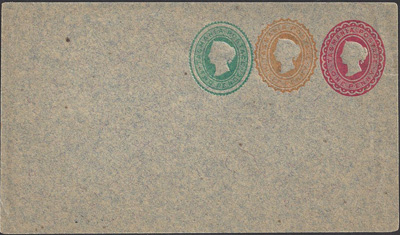
Fig 8
Some of the examples of STOs are bizarre. Why would anyone want to impress the stamp images on opposite sides of the envelope (refer diagram) or on the wrong corner? What possible purpose could be served by an envelope with 5 x ½d indica when one 2d and one ½d impression would serve the same purpose? The answer is that these peculiar combinations were attractive to collectors.
As well as combinations of indica, there are other possible approaches to collecting STOs. Since anyone could bring any type of envelope to the Post Office for stamping, STOs can be found in a wide range of sizes, shapes, colours, papers and flap shapes. Figure 8 shows a “tripleton” on grey granite paper. The embossing of maker’s names and monograms on envelope flaps is another fascinating subset of STO collecting; for Tasmania, no one has catalogued the known examples, although Higgins and Gage records variations for the state of Victoria.
Quite a few local businesses produced their own STO envelopes, with details of the business printed somewhere on the envelope. Examples of these commercial STOs are sought after, particularly used. “The Courier” has presented several articles on the businesses known to commission their own STOs. “Tasmanian Postal Stationery” lists more than fifty examples of commercial business use.
STO postcards and wrappers (refer above) also exist. The whole field offers a broad and deep range of opportunities for the collector or analyst.
Issues for Government Departments
Until 31 October 1902, all postage on departmental stationery was free, by application of the department’s frank stamp. Frank stamps, a separate subject in themselves, are highly collectible.
Subsequently, official stamps were no longer free and a wide range of stationery items were prepared for use within government departments and quasi-government agencies. All of these items are rare to almost invisible.
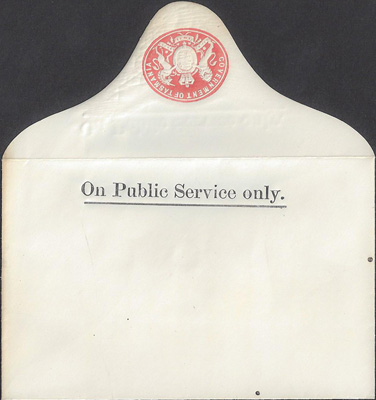
Fig 9
Ordinary postcards were perforated “T” for official use. Postcards were also inscribed with the names of various bodies including the Tasmanian Rifle Regiment and the Government Railways. Wrappers were inscribed for use in the conveyance of government papers – for example, “Legislative Council Papers, Tasmania”.
Then there were official envelopes. Amazingly, Tinsley lists over 90 different types, so there are probably well over 100 different official envelopes that might still exist. Most departments had their own envelopes, even to obscure agencies like the New Town Charitable Institution. Several different styles of envelope were produced for the larger departments and there were also special-purpose envelopes produced for the Tasmanian International Exhibition of 1894-5. It is an understatement to say that these envelopes are not often seen. Envelopes, as in figure 9, were also prepared for general use by government agencies.
Figure 9
While ordinary government mail was free up to 1902, registered mail always required a fee. There are several dozen types of official registered envelope, mostly designated to the State Treasury. Some are quite large, made specifically as savings bank or money order packets.
A collection of official Tasmanian Government postal stationery would be highly exhibitable – the difficulty arises in finding material.
Specimen Overprints and Cancellations
Philatelic items designated as “specimen” were originally intended as samples for UPU members, and not for philatelic use. Lots of examples found their way into private hands.
Postcards, lettercards, reply cards and registered envelopes exist with “specimen” overprints. Specimens were also produced by applying what we would now call a CTO postmark to postcards, reply cards and envelopes. A compilation of “Specimen” stationery would make an attractive and well-focused collection.
Sources
Tasmanian postal stationery is sought by a relatively small but keen population of collectors.
Items come up for sale on eBay and other online auction sites with reasonable frequency. The best sources of quality material are local and English philatelic auctions. Local (Tasmanian and other Australian) auctions often include a good range of postal stationery items, and the better-known English auctions offer collections, subdivided into lots, from time to time.
Postal history is a fascinating challenge, and an opportunity, for the patient collector. A 1d postcard, worth very little in itself, might display rare postal markings. Conversely, collections of common postmarks on entires may include scarce stationery items. Knowledge is power, as the scarcer items usually resemble those that are more common. The possibilities for specialisation are numerous and a little research into back issues of “The Courier” is highly recommended.
Allen Shatten
20 March 2022

